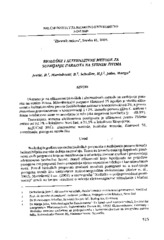Приказ основних података о документу
Biološke i alternativne metode za suzbijanje parazita na strnim žitima
Biological and alternative methods of parasite control in small grains
| dc.creator | Jevtić, Radivoje | |
| dc.creator | Marinković, Branko | |
| dc.creator | Schaller Jurgen, Hans | |
| dc.creator | Marga, Jahn | |
| dc.date.accessioned | 2023-12-03T17:57:50Z | |
| dc.date.available | 2023-12-03T17:57:50Z | |
| dc.date.issued | 2005 | |
| dc.identifier.issn | 0351-4781 | |
| dc.identifier.uri | http://fiver.ifvcns.rs/handle/123456789/4107 | |
| dc.description.abstract | Ukazano je na efikasnost bioloških i altemativnih metoda za suzbijanje parazita na strnim žitima. Mikrobiološki preparat Ekstrasol 55 ispoljio je visoku efikasnost u kulturi in vitro prema Cocbliobolus sativus u koncentraciji od 2%, a prema Fusarium graminearum u koncentraciji 1 i 2%. Između porasta gljive C. sativus i širine inhibicione zone ustanovljena je vrlo jaka negativna korelacija (r = -88,9%). Tretiranjem semena elektronima postignuta je efikasnost prema Tilletia tritici od 92,7% u lokalitetu Novi Sad, a 91,5% u lokalitetu Kragujevac. | sr |
| dc.description.abstract | Over the years, use of biological preparations to control causal agents of plant diseases has become increasingly significant. In addition, the contribution may be attributed to the advantages of the preparations manifested in environmental protection and safe food production. Besides their efficacy approved on individual pathogens, these preparations often increase the resistance and act as growth promoters as well. A 2% concentration of the Ekstrasol 55 preparation has proven to be the most efficient, as the growth of C. sativus ceased completely. Between the applied concentrations of 1% an 2% there were no statistically significant differences in the growth of mycelia of the fungus F. graminearum. Between the growth of C. sativus and the width of the inhibition zone, a very intensive negative correlation was found (r = -88.9%). The principle of electron treatment is the limitation of the effect of low-energy electrons to the outer layers of the seed in order not to damage the embryo. This technique is especially advantageous because of its compatibility with integrated plant protection systems. Efficacy in field conditions in T. tritici after e-treatments was 92.7% at Novi Sad and 91.5% at Kragujevac. | sr |
| dc.language.iso | sr | sr |
| dc.publisher | Novi Sad : Institut za ratarstvo i povrtarstvo | sr |
| dc.rights | openAccess | sr |
| dc.rights.uri | https://creativecommons.org/licenses/by/4.0/ | |
| dc.source | Zbornik radova Instituta za ratarstvo i povrtarstvo, Novi Sad | sr |
| dc.subject | e-tretiranje | sr |
| dc.subject | alternativne metode | sr |
| dc.subject | biološke metode | sr |
| dc.subject | Ekstrasol 55 | sr |
| dc.subject | paraziti | sr |
| dc.subject | small grains | sr |
| dc.subject | strna žita | sr |
| dc.subject | pathogens | sr |
| dc.subject | e-treatments | sr |
| dc.subject | tretiranje semena elektronima | sr |
| dc.subject | electron treatment | sr |
| dc.title | Biološke i alternativne metode za suzbijanje parazita na strnim žitima | sr |
| dc.title | Biological and alternative methods of parasite control in small grains | sr |
| dc.type | article | sr |
| dc.rights.license | BY | sr |
| dc.citation.epage | 519 | |
| dc.citation.spage | 515 | |
| dc.citation.volume | 41 | |
| dc.identifier.fulltext | http://fiver.ifvcns.rs/bitstream/id/9851/bitstream_9851.pdf | |
| dc.identifier.rcub | https://hdl.handle.net/21.15107/rcub_fiver_4107 | |
| dc.type.version | publishedVersion | sr |


